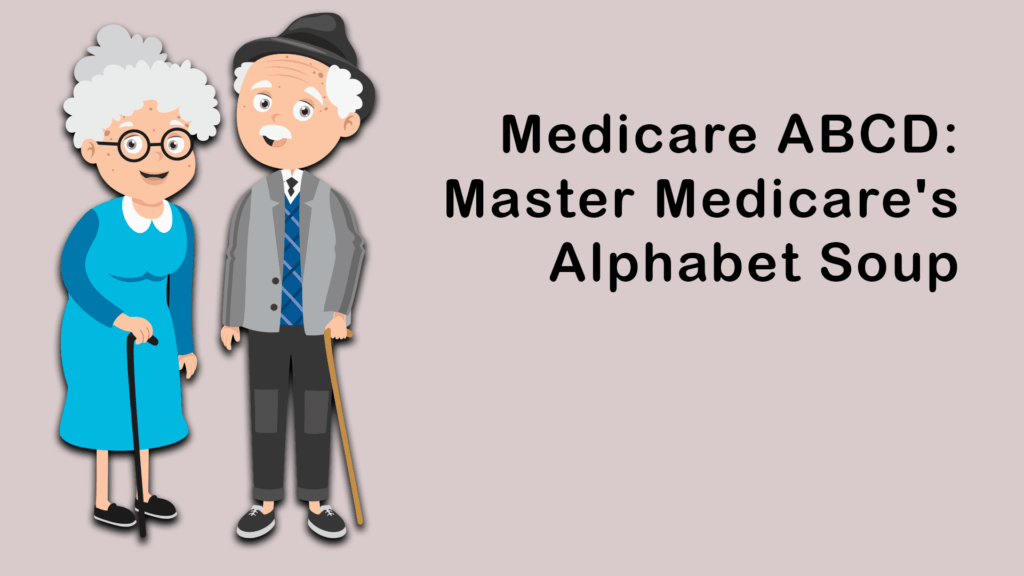When most people hear the word “Medicare,” a cloud of confusion instantly rolls in. We consider ourselves Medicare experts, but we have to admit, it’s not always easy to learn, especially when there is an alphabet soup of letters swimming throughout the program.
Today we hope to make sense of Medicare’s ABCDs by reviewing each part in detail.
Part A: Hospital Insurance
Part A is one of two parts included in what is referred to as Original Medicare.
Part A will help pay for your room and board expenses for an inpatient hospital stay. It also includes coverage for care received in a skilled nursing facility or nursing home and hospice and home health care. It does not include custodial or long-term care coverage.
Part A is accepted across the United States. Approximately 96% of all physicians accept Medicare assignment, which means they have agreed to provide service at the Medicare-approved amount.
The Cost of Part A
Premiums
Most Medicare beneficiaries enjoy premium-free Part A. You or your spouse must have worked and paid Medicare taxes for ten years (or 40 quarters) to be eligible for premium-free Part A. The taxes you pay while working help provide the Part A benefits you enjoy during retirement.
If you haven’t met that requirement, you can still enroll in Part A but will pay a premium based on how many quarters you contributed. For example, if you contributed for at least 30 quarters, your monthly premium would be $274. Any amount of time less than 30 quarters will cause you to pay the full premium, which is $499 in 2022.
Deductibles
Before your coverage begins, you’ll be responsible for a $1556 deductible. This is a benefit period deductible. A benefit period begins the first day you are admitted as an inpatient and ends after being hospital-free for 60 consecutive days.
Coinsurance / Copays
Once you’ve paid your deductible, Part A will pay for the first 60 days of your hospital stay. From days 61-90, your portion will be $389 per day. Starting on day 91, you can use some or all of the 60 lifetime reserve days if you have them available. Your coinsurance during this time is $778 per day. Once all of your benefits have been exhausted, you’ll be responsible for the full daily expense.
Coinsurance during a skilled nursing facility stay is different. First, you must pay the deductible and have a qualifying 3-day inpatient hospital stay, then Part A will pay for the first 20 days of your stay. Days 21 – 100 will cost you $194.50 each day.
Part B: Outpatient Insurance
Part B is the second part included in Original Medicare.
Part B is your outpatient or medical insurance. It includes benefits for preventive services, doctor’s visits, diagnostic tests and images, durable medical equipment (DME), surgeries, and other outpatient services.
Some preventive services include a “Welcome to Medicare” preventive visit, annual wellness exams, many vaccines, bone density scans, cancer screenings, and much more.
Just like Part A, you can use Medicare Part B all over the U.S.
The Cost of Part B
Premiums
The standard monthly premium for Medicare Part B is currently $170.10. While most beneficiaries fall into the standard premium category, you could pay an additional amount called the Income Related Monthly Adjustment Amount (IRMAA) if you earn a higher income.
The Social Security Administration (SSA) calculates IRMAA by looking at your tax return from two years ago. Married couples filing jointly who had a Modified Adjust Gross Income (MAGI) of more than $182,000 will pay IRMAA. The first threshold adds $68 to your monthly premium. After that, amounts will increase at specified incomes.
Deductibles
The Part B deductible is currently $233. Unlike the Part A deductible, this one is only paid once per calendar year.
Coinsurance / Copays
Once you’ve paid your annual deductible, Medicare Part B works on an 80/20 split. Medicare will pay for 80% of the cost of covered services, and you will be responsible for the remaining 20%. If your provider does not accept Medicare assignment, you could pay Part B excess fees. Excess fees are charges over the Medicare-approved amount.
It’s important to note that neither Part A nor Part B has any limits on your out-of-pocket expenses. This is different than most group health plans, which usually have a maximum on what you would need to pay out-of-pocket each year.
Late-Enrollment Penalty
A few penalties apply in Medicare, and the Part B penalty is one of them. If you do not enroll in Part B during your Initial Enrollment Period (IEP), you will incur a penalty. Your IEP is a 7-month window around your 65th birthday.
The only way to delay Part B enrollment without being penalized is to have other creditable coverage in place. For example, suppose you are enrolled in an employer-sponsored health plan and that employer has at least 20 employees. In that case, your coverage will be deemed creditable, and you can postpone enrolment with no penalty. Be sure to check with your benefits manager or HR department if you consider delaying your Medicare enrollment.
If you were to incur the penalty, it is an extra 10% for each year you were eligible for benefits but did not enroll. The penalty is added to your Part B monthly premium and will never be removed.

Part C: Medicare Advantage
Part C is an alternative way to get your Part A and B benefits. Individuals who choose to enroll in a Part C plan will have their benefits provided by a private insurance company instead of the federal Medicare program.
A Part C plan will include at least the same benefits as you have in Parts A and B, but they also usually have additional benefits. For example, Medicare Advantage plans can include routine dental care, vision and hearing services, transportation services, meal delivery, gym memberships, and more. Some plans also include prescription drug coverage.
Your exact coverage will depend on which Part C plan you choose. Not all plans are available everywhere. Each plan uses a provider network, either in the form of a Health Maintenance Organization (HMO), a Preferred Provider Organization (PPO), or some variation of those. The provider networks are part of what keeps the cost of these plans low.
The Cost of Part C
Since Part C plans vary greatly, so do their costs. You’ll have monthly premiums, deductibles, coinsurance, and copays to consider. Plus, you must still pay your Part B premium.
Some Medicare Advantage plans have a $0 premium. However, that does not make these plans “free.” You’ll need to read and understand the summary of benefits to determine which expenses you’ll be responsible for paying.
Part D: Prescription Drug Plans
Part D includes all prescription drug plans. Like Part C plans, these are provided by private insurance companies. There are many plans to choose from. To decide which plan is right for you, you will need to consult the plan’s drug formulary and make sure your current medications are included in the plan’s coverage.
The Cost of Part D
Your Part D premiums will depend on which plan you choose. The more prescriptions you take and the more coverage you need, the higher the premium. You’ll also pay IRMAA for a Part D plan if you earn a high income. Falling into the first category will result in an additional $12.40 added to your premium.
Most Part D plans use the standard deductible, which is $480 in 2022. Your plan’s deductible could be lower, but it will never be higher than the standard deductible.
Outside of your premium and deductible, your coinsurance or copay for medications will depend on the plan and how each medication is categorized.
Late-Enrollment Penalty
The Part D penalty is the most common one in Medicare. The penalty often occurs because if an individual is not taking any medications, they assume they don’t need to sign up for prescription drug coverage. Not doing so will result in a penalty. You’ll incur a penalty for each month you went without coverage, and that penalty will stay with you for life.
The Coverage Gap
One last thing about Part D costs. There is something called the “coverage gap” or “donut hole” built into every Part D plan. After you and your plan have paid a certain amount, you will fall into this coverage gap. During that time, you’ll pay more for your medications. Once you have paid a set amount, you’ll end up in catastrophic coverage, and most of your prescriptions will be paid for at a higher rate.
Bonus! Medicare Supplement Plans
Medicare supplement plans, also called Medigap plans, fall outside of Medicare A-D. We mention them now so that you are aware there is one more option you have to supplement your coverage with Medicare Parts A and B.
Beneficiaries will choose either a Medicare Advantage plan or a Medicare supplement plan – you can’t have both.
Medigap plans have an alphabet soup entirely their own, but we’re just going to review the basic principles for now. These plans are designed to fill in the coverage gaps in Original Medicare. They will help with deductibles, copays, and coinsurance costs.
Private insurance companies sell Medicare supplements, but they are standardized plans. There are just ten Medicare supplements, and the benefits of each stay the same no matter where you purchase one.
Unlike Medicare Advantage plans, they do not offer coverage for anything outside of the coverage found in Parts A and B. However, there are no provider networks, so you can use a Medicare supplement wherever Medicare is accepted.
The Cost of Medicare Supplements
We said that there are ten Medicare supplements. Your premium, deductible, and coinsurance costs will depend on which one of those ten plans you choose.
Your premium will also depend on your age, gender, tobacco use, and where you live.
We’ve given you lots of information to absorb here, but we hope this helps you understand the parts of Medicare. If you have additional questions, we’re here for you. Give our office a call and speak with one of our licensed insurance agents.


